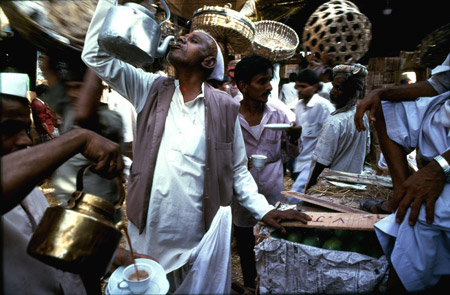Susan Sontag questions whether or not a photograph “captures reality,” or interprets it. Capturing reality versus interpreting it through a photograph draws focus on the events being framed, and whether or not the photographer chooses to capture a moment in order to convey something else. As I observed Raghubir Singh’s photographs of India, I understood that he was not only trying to capture India’s culture itself, but also to frame and interpret the lives of people who were inhabiting post-partition India.
Raghubir Singh was a phenomenal color street artist, whom focused his photography back into India, after living around the world. Singh used vibrant colors and interesting angles to photograph India and the lives within in. He often took photographs of people he would interact with on the street while he captured the normality of life at that time. In post-partitioned India, many of the religious people in India became refugees due to religious persecution. The lives of everyone in India were uplifted and changed after the British partition.
Through Singh’s photography, he demonstrates the struggle that the people of India faced during this time. The most interesting part of Singh’s photographs to me was the fact that he was able to capture such a difficult time India and shine light onto the everyday struggles, while creating such breath taking photos filled with color and light. In a way, he brought the beauty out from Indias culture, while documenting the lives after the partition.

Through the art of photography, Singh was able to capture single moments of people’s lives and the standard of living, while simultaneously interpreting the overall political and historical climate at the time in India. One of my favorite photographs that I saw at the exhibit was a photograph of a man drinking right out of a metal pot in the midst of chaos, while people pour drinks and find food around him. I love the way that Singh is able to capture the calm in the storm in each of his pictures. He is able to focus on one subject in each photograph, while encapsulating the chaos and struggle around them. While Susan Sontag argues whether or not a photograph can capture a moment or interpret one, I believe that Raghubir has the sheer talent to do both simultaneously in each photograph, by interpreting the overall effects of the partition on India while capturing the moment’s of individuals living there.


I also didn’t know anything about Singh going into the exhibit, but I really liked all of the background the museum gave on his history as an artist and who he worked with. My favorite part was the Indian artist who made the movie in the style of Italian neo-realism.
I love the way you interpreted Singh’s goal and it being that there is something good and beautiful in every situation is inspiring! I hadn’t thought of it that way! Also, it was interesting to think of his photos as “the calm in the storm,” when observing the man drinking water. Great eye-opening way of looking at post-colonial India!
Wow, I loved what you said about how Singh was able shine light in the everyday rough situation in India. I also loved all the colors and vibrancy in the photos. Yet, these photos portrayed a rough reality. I think it’s quite the skill for an art for the photographer to be able to deliver and capture an attractive and vibrant piece given and cold reality.
Well said!